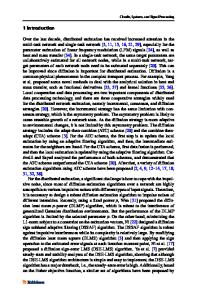A note on the forward order law for least square g -inverse of three matrix products
- PDF / 290,952 Bytes
- 7 Pages / 439.37 x 666.142 pts Page_size
- 81 Downloads / 251 Views
A note on the forward order law for least square g-inverse of three matrix products Zhongshan Liu1 · Zhiping Xiong1 · Yingying Qin1 Received: 12 July 2018 / Revised: 16 December 2018 / Accepted: 17 January 2019 © SBMAC - Sociedade Brasileira de Matemática Aplicada e Computacional 2019
Abstract The generalized inverse has many important applications in the aspects of theoretic research of matrices and statistics. One of the core problems in generalized inverse is to find the necessary and sufficient conditions of the forward order laws for generalized inverse of matrix product. In this paper, by using the expressions for maximal ranks of the generalized Schur complement, we obtain some necessary and sufficient conditions for the forward order laws A1 {1, 3}A2 {1, 3}A3 {1, 3} ⊆ (A1 A2 A3 ){1, 3} and A1 {1, 4}A2 {1, 4}A3 {1, 4} ⊆ (A1 A2 A3 ){1, 4}. Keywords Forward order law · Generalized inverse · Maximal rank · Matrix product · Generalized Schur complement Mathematics Subject Classification 47A05 · 15A09 · 15A24
1 Introduction Let C m×n denote the set of m × n matrices with complex entries and C m denote the set of m-dimensional vectors. Im denotes the identity matrix of order m and Om×n is the m × n matrix of all zero entries (if no confusion occurs, we will drop the subscript). For a matrix A ∈ C m×n , A∗ denotes the conjugate transpose of A, and r (A), R(A), N (A) denote the rank, the range space and the null space of A, respectively.
Communicated by Orizon Pereira Ferreira. This work was supported by the National Natural Science Foundation of China (nos: 11771159, 11571004) and the Natural Science Foundation of GuangDong (no: 2014A030313625) and the Training plan for the Outstanding Young Teachers in Higher Education of Guangdong (no: SYq2014002).
B 1
Zhiping Xiong [email protected] School of Mathematics and Computational Science, Wuyi University, Jiangmen 529020, People’s Republic of China
123
Z. Liu et al.
Let A ∈ C m×n , a generalized inverse X ∈ C n×m of A is a matrix which satisfies some of the following four Penrose equations Penrose (1955): (1) AX A = A, (2) X AX = X , (3) (AX )∗ = AX , (4) (X A)∗ = X A.
(1.1)
For any matrix A ∈ C m×n , let A{i, j, . . . , k} denote the set of matrices X ∈ C n×m which satisfy equations (i), ( j), . . . , (k) from among equations (1), (2), . . . , (4) of (1.1). A matrix in A{i, j, . . . , k} is called an {i, j, . . . , k}-inverse of A and denoted by A(i, j,...,k) . One usually denotes any {1, 3}-inverse of A as A(1,3) which is also called a least square g-inverse of A. Any {1, 4}-inverse of the set A{1, 4} is denoted by A(1,4) which is called a minimum norm g-inverse of A. The unique {1, 2, 3, 4}-inverse of A is denoted by A† , which is called the Moore–Penrose inverse of A. We refer the reader to Ben-Israel and Greville (2003), Penrose (1955) and Wang et al. (2004) for basic results on the generalized inverse. Theory and computations of the reverse (forward) order laws for generalized inverse are important in many branches of applied sciences, such as non-linear
Data Loading...











